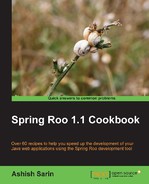In previous recipes we saw how to create mock and integration tests for persistent entities. In this recipe we'll look at how to execute these tests using the perform tests command of Spring Roo.
Exit the Roo shell and delete the contents of the C:
oo-cookbookch02-recipes directory.
Execute the ch02_jsr303_fields.roo script. It creates a flight-app Roo project and sets up Hibernate as the persistence provider using the persistence setup command. The script also creates a Flight entity, which has FlightKey as its composite primary key class, and adds fields to the Flight and FlightKey classes. If you are using a different database than MySQL or your connection settings are different from what is specified in the script, then modify the script accordingly.
Install the MySQL 5.5.11 database—this is required because we'll now be executing integration tests. Create a database named "myFlightAppDB" in MySQL server instance and ensure that the connection properties defined in the database.properties file of the flight-app Roo project can be used to successfully connect to "myFlightAppDB".
Start the Roo shell from the C:
oo-cookbookch02-recipes directory.
Follow these steps to create and execute tests:
- Change the focus of Roo commands to
Flightentity:roo> focus --class ~.domain.Flight - Execute the
testintegrationcommand to create integration tests for theFlightentity:~.domain.Flight> test integration - To execute tests defined in the Roo project, issue the
performtestscommand from the Roo prompt, as shown here:roo> perform tests
The integration test for the Flight entity will fail currently because:
- The auto-generated 'data on demand' class provides limited support for creating entity instances that comply with JSR 303 annotations. As explained in the Creating integration tests for persistent entities recipe, you can write custom setter methods for persistent fields in the
FlightDataOnDemand.javaentity to createFlightentities that comply with JSR 303 annotations specified on the persistent fields. - The query fired by the
countFlightsmethod in theFlight_Roo_Entity.ajAspectJ ITD file doesn't work with MySQL 5.1.1. You need to change thecountFlightsmethod from:public static long countFlights() { return entityManager().createQuery("SELECT COUNT(o) FROM Flight o", Long.class).getSingleResult(); }To:
public static long countFlights() { return entityManager().createQuery("SELECT COUNT(*) FROM Flight o", Long.class).getSingleResult(); }
As AspectJ ITD files are managed by Spring Roo, you should not change the countFlights method in the Flight_Roo_Entity.aj file. Instead, either perform push-in refactoring or create a countFlights method in the Flight.java file.
In push-in refactoring, you use the IDE to push the declarations, methods, attributes, and constructors defined in the AspectJ ITD file to the target Java class. For more information on push-in refactoring, refer to the Removing Roo with push-in refactoring recipe of Chapter 7.
Note
When writing countFlights method in Flight.java, make sure that Roo is running in the background, so that Roo can remove the countFlights method from the Flight_Roo_Entity.aj file. Additionally, ensure that the signature of countFlights method is same as the one defined in the Flight_Roo_Entity.aj file.
The perform tests command is processed by the maven add-on
of Roo and is responsible for executing all the tests that form part of the Roo project. If you want to directly execute the tests using maven, then exit the Roo prompt and use the mvn test command of maven. The results of test execution are saved in the <project_dir>/target/surefire-reports directory, where project_dir is your Roo project directory.
The ch02_flightapp_testing.zip file that accompanies this book contains the flight-app Eclipse project that we saw in recipes of the previous chapter and this chapter. You can import this project into your Eclipse IDE and view the following changes that I made to the flight-app project to demonstrate concepts that we've learned so far:
- Defined the
setNumOfSeatsmethod inFlightDataOnDemand.javato createFlightentities that meet the constraint specified by the JSR 303@Sizeannotation for thenumOfSeatsfield. Defining thesetNumOfSeatsmethod inFlightDataOnDemand.javaresults in the removal of the method with the same signature from theFlightDataOnDemand_Roo_DataOnDemand.ajfile. - Defined
setOriginandsetDestinationmethods inFlightDataOnDemand.javato createFlightentities that meet the constraints specified by JSR 303@DecimalMaxand@DecimalMinannotations onoriginanddestinationfields. DefiningsetOriginandsetDestinationmethods inFlightDataOnDemand.javaresults in removal of methods with the same signature from theFlightDataOnDemand_Roo_DataOnDemand.ajfile. - Changed the
@RooIntegrationTestannotation inFlightIntegrationTest.javato instruct Roo not to generatefindAll,findEntries, andcounttest methods. - Autowired
MyFlightDodreference (a custom 'data on demand' class) inFlightIntegrationTest.javaand defined a customtestMyCustomDodTestmethod. - Added a
@Rollback(false)Spring annotation to thetestPersistmethod inFlightIntegrationTest.javaso that the data created by thetestPersistmethod is not rolled back after it is executed. This feature could be particularly useful if you want to manually verify the data that was created by thetestPersistmethod or if you want to keep the data for further testing.
You can execute the tests defined in the flight-app project using the perform tests command and check your database to view the seed data that was created by the 'data on demand' class and during the testing of testPersist method.
